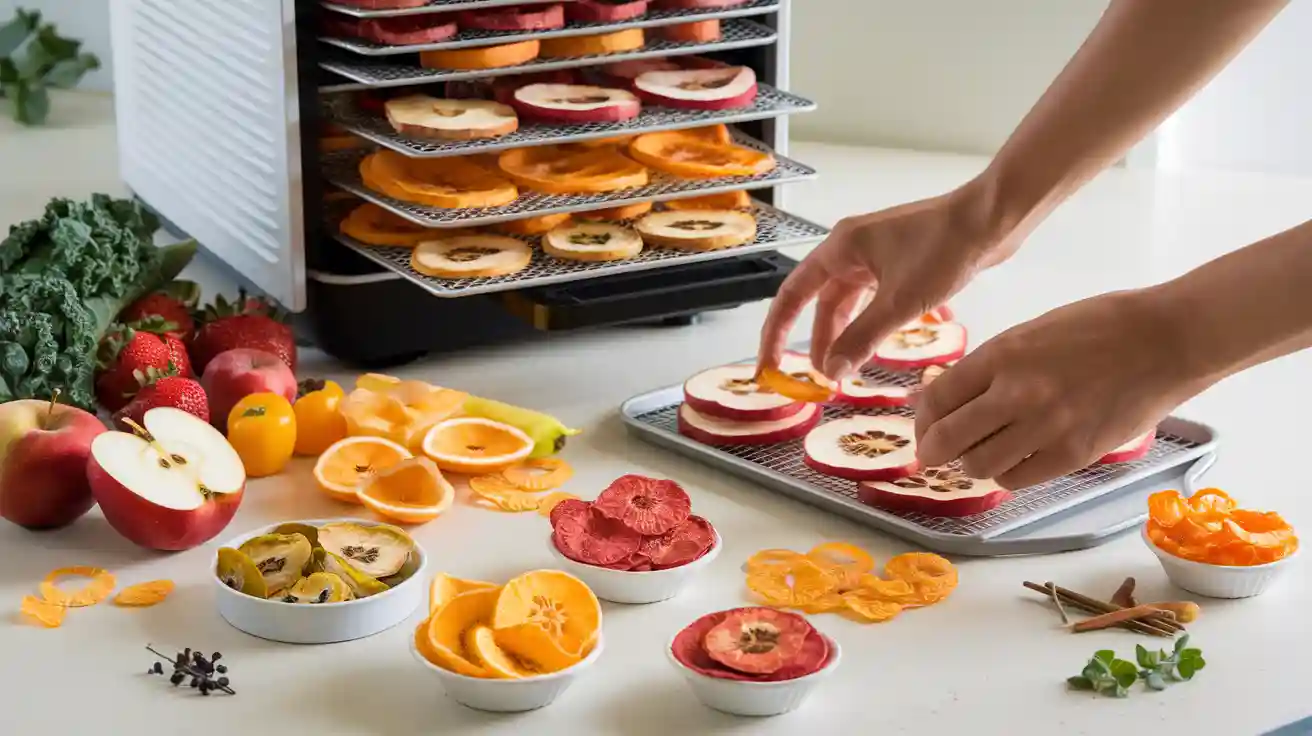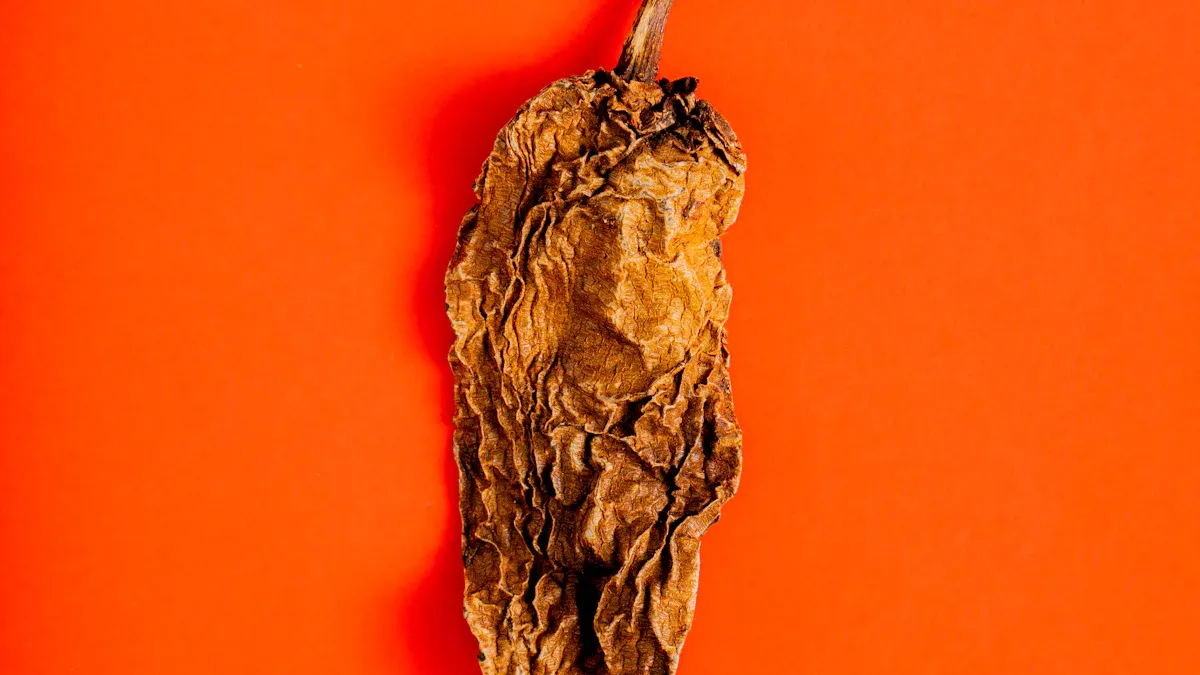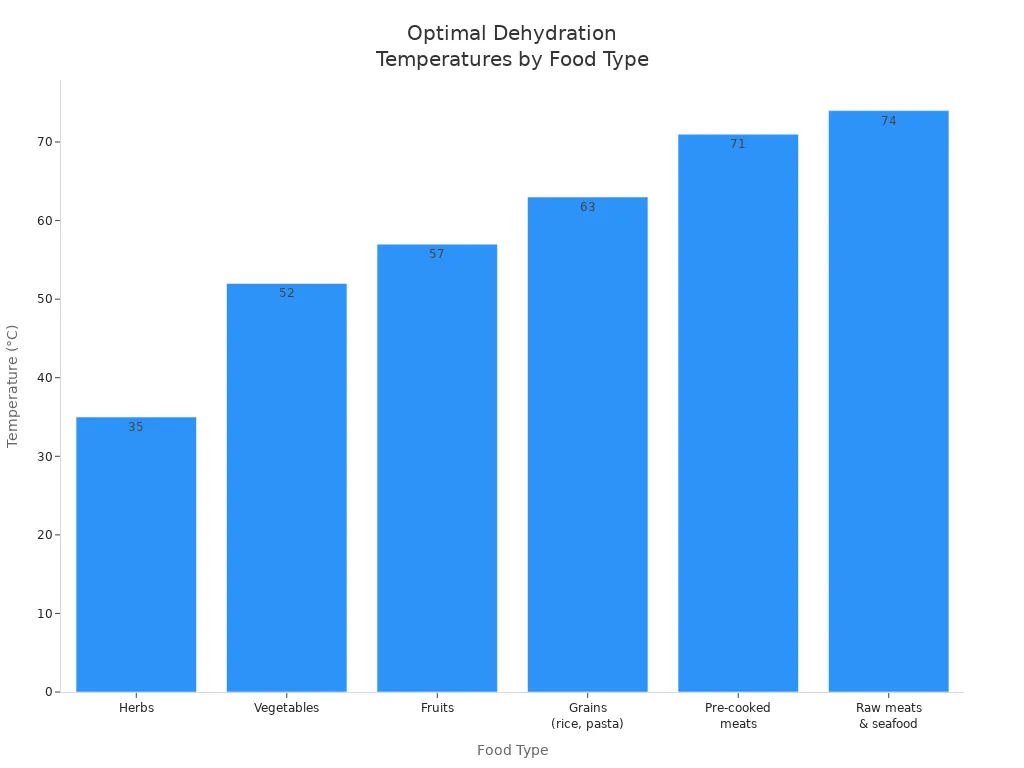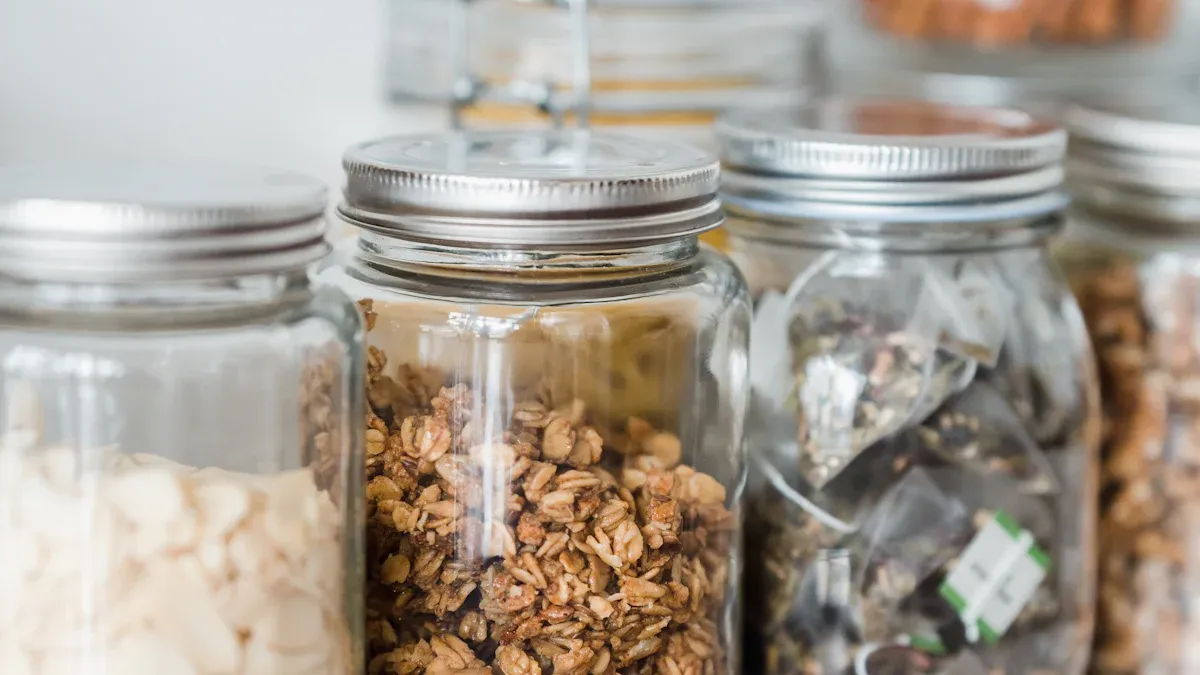
When you dehydrate food, you keep about 95-97% of its nutrients. Dehydrating food helps you lock in minerals and fiber, while only a small amount of vitamins are lost. Good preparation and careful dehydrating let you make tasty, healthy food at home.
How Dehydrating Food Impacts Nutrition and Flavor
The Science Behind Dehydration
When you use food dehydration, you remove water from food by evaporation. This process stops bacteria and mold from growing. Heat and air movement help water leave the food, but do not cook it. You can use a dehydrator, oven, or even the sun. Smaller pieces of fruits and vegetables dry faster because they have more surface area. Dry air and steady temperature make dehydration work best. Removing water makes food lighter and easier to store.
- Dehydration slows down spoilage by taking away the moisture that microbes need.
- Air circulation keeps the drying even and prevents water from coming back into the food.
- Sugars and salts in food help bind water, making it even harder for microbes to grow.
Effects of Dehydration on Vitamins and Minerals
Dehydrating food keeps most of its essential nutrients, but some vitamins are sensitive to heat. You may lose some vitamin C and B vitamins during dehydration. Minerals like iron and calcium stay in the food. The table below shows how much of certain vitamins you might lose:
| Vitamin | Percentage Loss During Dehydration |
|---|---|
| Vitamin C | About 30% |
| Niacin | 5-15% |
| Thiamine | About 15% |
Fruits and vegetables still keep their nutritional content and become nutrient-dense snacks. Most calories, protein, fat, fiber, and minerals remain after dehydrating.
How Dehydrating Food Concentrates Flavor
Dehydrating food gives you a concentrated flavor. When you remove water, the natural sugars and flavors in fruits and vegetables become stronger. Dehydrated fruits taste sweeter, and vegetable chips have a richer taste. This process also makes food more calorie-dense, so you should watch your portions. Dehydration preserves food, extends shelf life, and reduces waste. You get snacks that are easy to carry and full of taste.
Choosing Foods and Equipment for Food Dehydration

Selecting the Best Ingredients for Dehydrating
You get the best results from dehydrating food when you start with high-quality ingredients. Always pick fresh produce during its peak season. This gives you the most flavor and nutrition. Wash all fruits and vegetables well to remove dirt and pesticides. Slice them evenly, about 1/4 to 1/2 inch thick, so they dry at the same rate. Remove any tough skins, bruises, or bad spots. For vegetables like carrots or potatoes, blanch them by steaming for a few minutes. This step helps keep their color and nutrients. If you want to dehydrate fruits like apples or pears, dip them in lemon juice to stop browning. Avoid foods high in fat or oil because they do not dry well and spoil quickly. Lay out your pieces in a single layer on the tray to allow good airflow.
Tip: Use parchment paper for delicate items such as herbs or fruit purees to prevent sticking.
Types of Dehydrators and Food Dehydration Methods
You can choose from several dehydration methods. The most common are electric dehydrators, oven drying, sun drying, and air drying. Electric dehydrators work best for most people. They use fans and heat to dry food evenly and quickly. Oven drying is handy if you do not have a dehydrator, but it uses more energy and works for small batches. Sun and air drying cost less but depend on the weather and take longer. Freeze drying keeps flavor and nutrients well but needs special equipment.
| Method | Advantages | Disadvantages |
|---|---|---|
| Electric Dehydrators | Fast, even drying, large batches, easy to use | Cost, needs electricity, can be noisy |
| Oven Drying | No extra equipment, good for small amounts | Uses more energy, risk of over-drying |
| Sun/Air Drying | Low cost, no electricity needed | Weather dependent, slow, risk of contamination |
| Freeze Drying | Best for flavor and nutrients, long shelf life | Expensive, special equipment needed |
Essential Tools for Dehydrating Food at Home
You need the right tools for safe and effective food dehydration. Choose a dehydrator with adjustable temperature controls. This lets you set the best temperature for different foods. Large trays help you dry more at once. A timer helps you avoid over-drying. Look for trays that are easy to clean. Models with rear-mounted fans and heating elements give even airflow. Avoid cheap stackable models without fans, as they can cause uneven drying and even bacterial growth. Electric dehydrators, such as Excalibur, help you keep nutrients and natural flavors in your food.
Note: Good preparation and the right equipment make dehydrating food easier and safer.
Preparation and Dehydration Techniques for Maximum Nutrition
Slicing and Preparing Foods for Dehydration
Proper preparation is the first step to successful dehydrating food. You want to slice fruits thinly and evenly. Thin slices dry faster and more evenly, which helps keep the texture and taste. For vegetables, steam them before drying. Steaming helps keep their color and nutrients. When you prepare fruits, soak the slices in an ascorbic acid solution. This step prevents browning and keeps the food looking fresh. Always wash your produce well and remove any bruised or damaged spots. Use a sharp knife or a mandoline slicer for even cuts.
- Slice fruits thin for even dehydration and better taste.
- Steam vegetables to keep color and nutrients.
- Soak fruit slices in ascorbic acid to stop browning.
- Wash and trim all produce before drying.
Tip: Even slices help all pieces finish drying at the same time, so you avoid over-drying or under-drying.
Pretreating Fruits and Vegetables Before Dehydrating
Pretreatment helps preserve the color, flavor, and nutrients in your food. Different methods work best for different foods. The table below shows common pretreatment methods and their benefits:
| Pretreatment Type | Application to Fruits | Application to Vegetables | Benefits for Color, Flavor, Nutrients and Drying Process |
|---|---|---|---|
| Acidic Solutions | Soak cut fruits in ascorbic acid, citric acid, or lemon juice solutions for ~10 minutes | Blanch in citric acid solution (1/4 tsp per quart water) | Reduces oxidation, preserves color, reduces vitamin loss, extends shelf life, destroys harmful bacteria |
| Syrup Blanching | Simmer fruits in sugar and corn syrup syrup for 10 min, then soak 30 min in hot syrup | N/A | Enhances sweetness and color retention, but results in stickier fruit |
| Boiling Water Dip | Dip fruits like blueberries and cranberries briefly to crack skins | N/A | Facilitates drying by cracking skins without mushiness, preserves texture and flavor |
| Blanching (Steam or Water) | N/A | Steam blanch or water blanch vegetables | Destroys microorganisms, slows enzyme activity, softens cell structure, improves drying and rehydration |
| No Blanching Needed | N/A | Onions, garlic, peppers, herbs do not require blanching | Avoids unnecessary processing while preserving quality |
Pretreating fruits and vegetables before dehydration keeps your snacks colorful and tasty. It also helps you keep more nutrients in your food.
Temperature and Timing in Food Dehydration
You need to use the right temperature and timing to keep nutrients and flavor in your dehydrated foods. Each type of food has its own best temperature. The chart below shows the optimal drying temperatures for different foods:

| Food Type | Optimal Drying Temperature | Timing Guidelines / Notes |
|---|---|---|
| Herbs | ~95°F (35°C) | Low temperature preserves delicate flavors and essential oils |
| Vegetables | ~125°F (52°C) | Retains color and nutrients; timing varies with thickness and humidity |
| Fruits | ~135°F (57°C) | Maintains sweetness and nutrition; high-water fruits may need 12-24 hours |
| Grains (rice, pasta) | ~145°F (63°C) | Ensures thorough dehydration without texture loss |
| Pre-cooked meats | ~160°F (71°C) | Ensures safety by eliminating pathogens |
| Raw meats & seafood | ~165°F (74°C) | Higher temp needed for safety; avoid case hardening |
You should check the moisture level often. If the outside dries too fast, the inside can stay wet, which causes spoilage. Use the right temperature to keep vitamins A and C from breaking down. Rotate trays or use a dehydrator with good airflow for even drying. Timing depends on the thickness of your food, the humidity, and your dehydrator’s power. Always monitor your food to get the best results.
Dehydrating Fruits for Best Results
Dehydrated fruits make a sweet and healthy snack. You can get the best texture and flavor by using a few key techniques:
- Use acid pretreatments like ascorbic acid, citric acid, or lemon juice to keep color and reduce browning.
- Crack the skins of tough-skinned fruits, such as grapes or cherries, by dipping them in boiling water for a few seconds, then cooling them quickly.
- Try syrup-blanching for a candied texture and extra sweetness.
- Use a commercial dehydrator with controlled temperature and airflow for even drying.
- Condition your dried fruits after drying by placing them in a sealed container for a few days. This step helps equalize moisture and improves texture.
Note: Acid pretreatments and syrup-blanching help you keep the best flavor and texture in your dehydrated fruits.
Dehydrating Vegetables for Maximum Nutrition
You can keep more nutrients in your vegetables by following modern dehydration methods. Start with fresh, high-quality produce. Use pre-treatments like blanching or dipping in ascorbic acid to stop oxidation and keep nutrients. Slice vegetables evenly for uniform drying. Watch the time and temperature closely. Over-drying can break down nutrients, while under-drying can make food unsafe. Store your dried vegetables in airtight containers away from moisture and light.
- Pick fresh vegetables for the most nutrients.
- Blanch or dip in ascorbic acid to keep color and vitamins.
- Slice evenly for even drying.
- Monitor drying time and temperature.
- Store in airtight containers to keep nutrients safe.
Vacuum-belt drying and freeze-drying are the best for keeping color, shape, and nutrients, but home dehydrators also work well if you follow these steps.
Dehydrating Meats Safely and Flavorfully
Dehydrating meats needs careful preparation to keep your meal safe and tasty. Always use lean meat. Wash your hands and all equipment before and after handling raw meat. Thaw meat in the refrigerator, not at room temperature. Marinate meat in the refrigerator and never reuse marinade. Heat meat strips in marinade to an internal temperature of 160°F before drying. This step kills harmful bacteria. Dry meat at 130-140°F to lower water activity and stop bacteria from growing. Use a calibrated thermometer to check the temperature. Store dried meat in airtight containers.
- Use lean meat and keep it cold until ready to use.
- Wash hands and sanitize all tools and surfaces.
- Thaw meat in the refrigerator.
- Marinate and preheat meat to 160°F before drying.
- Dry at 130-140°F for safety and flavor.
- Store in airtight containers.
Safety Alert: Always cook meat to the right temperature before drying to prevent foodborne illness.
Enhancing Flavor When You Dehydrate Food
Seasoning Foods Before Dehydration
You can boost the taste of dehydrated foods by seasoning them before drying. Start with fresh spices and herbs at their peak. Freshness gives you the strongest flavor. Dry your spices using a dehydrator with silicone mats. This method prevents loss and helps the spices dry evenly. Store dried spices whole in a cool, dry, and dark place. Whole spices keep their flavor for up to a year. Grind your spices just before you use them. This step releases the best aroma and taste.
When you make seasoning blends, grind herbs and spices together. This ensures even flavor in every bite. If you want to add spices to dried fruits or vegetables, cut them into small pieces and freeze them for a short time before grinding. This trick stops the pieces from gumming up your grinder.
| Food Type | Preparation Technique | Purpose/Benefit |
|---|---|---|
| Fruits | Slice thinly | Ensures even drying, reduces drying time, enhances texture and taste |
| Vegetables | Steam before drying | Retains color and nutrients, improves flavor and appearance |
| Fruits | Pretreat with ascorbic acid | Prevents oxidation and browning, maintains visual appeal and flavor |
Tip: Seasoning your food before dehydrating helps you lock in flavor and create snacks that taste great.
Combining Foods for Unique Dehydrated Flavors
You can create new and exciting flavors by combining different foods before dehydrating. Mixing fruits, vegetables, nuts, and even legumes lets you make snacks with unique textures and tastes. For example, blend fruits into a puree to make fruit leathers. Try mixing berries and bananas for a sweet and tangy treat. Marinate vegetables before drying to add depth. Mushroom jerky or carrot bacon can taste savory and rich, almost like meat.
Seasoning vegetables before dehydrating, such as coating kale leaves with spices, gives you custom chips. Add spices and flavorings during preparation. Lemon garlic dill squash chips or cheesy chickpea croutons show how you can personalize your snacks. You can also combine whole ingredients, like pumpkin and pecans, to make granola bars. These bars use natural sweeteners and spices for a tasty meal or snack.
Note: When you experiment with flavor combinations, you discover new favorites and keep your snacks interesting.
Avoiding Blandness in Dehydrated Food
You want your dehydrated foods to taste as good as possible. Avoid blandness by using the right preparation and seasoning steps. Always start with high-quality, ripe produce. Slice fruits and vegetables thinly and evenly. This helps them dry well and keeps their natural taste. Steam vegetables before drying to keep their color and flavor. Pretreat fruits with ascorbic acid to stop browning and keep them tasting fresh.
Try different spice blends and marinades. Taste your food before dehydrating to check the seasoning. Adjust as needed. Store your dried foods in airtight containers to keep the flavor strong. If you notice your snacks taste dull, add a sprinkle of fresh ground spices before eating.
- Use fresh, ripe ingredients for the best taste.
- Slice and prepare foods carefully.
- Season and taste before drying.
- Store in airtight containers to keep flavor.
Callout: Dehydrating does not mean you have to settle for bland snacks. With the right steps, you can enjoy bold and delicious flavors in every bite.
Preventing Nutrient Loss During Dehydration
Avoiding Overheating in Food Dehydration
You can protect nutrients by keeping the temperature steady while dehydrating. High heat destroys vitamins A and C. If you use too much heat, you risk case hardening, which traps moisture inside and causes spoilage. Always set your dehydrator to the recommended temperature for each type of food. Use a thermometer to check the heat. Rotate trays to make sure all pieces dry evenly. If you dry food at a lower temperature for a longer time, you keep more nutrients and improve food preservation.
Tip: Never rush the process by turning up the heat. Slow and steady drying helps you keep more vitamins and minerals.
Preventing Oxidation While Dehydrating Food
Oxidation happens when air and light break down nutrients, especially vitamin C. You can reduce oxidation by using pretreatments like blanching or dipping fruits in ascorbic acid. These steps stop enzymes that cause browning and nutrient loss. Slice your food evenly so it dries at the same rate. Store your dried food in airtight containers in a cool, dark place. This method keeps out air and light, which helps with long-term preservation and food quality.
- Start with fresh, high-quality produce.
- Use acid dips or blanching to protect color and nutrients.
- Store dried food away from heat and sunlight.
Common Mistakes in Dehydrating and How to Fix Them
Many people make mistakes that lead to nutrient loss or spoilage. Watch out for these common problems:
- Using too high a temperature, which destroys nutrients and causes case hardening.
- Not slicing food evenly, which leads to uneven drying.
- Skipping pretreatments, which allows oxidation and loss of color.
- Storing dried food in containers that let in air or moisture.
You can fix these mistakes by following best practices for food preservation. Always monitor temperature, use proper pretreatments, and store your food correctly. This way, you keep more nutrients and enjoy safe, tasty snacks.
Storing Dehydrated Food for Quality and Nutrition

Best Storage Containers for Dehydrated Food
Choosing the right containers is a key step in food preservation. You should always let dehydrated foods cool completely before packaging. This prevents moisture from building up inside the container. Use clean, dry, and insect-proof containers for the best results. Good options include glass jars, plastic freezer containers with tight lids, and plastic freezer bags. Vacuum sealing removes air and helps extend shelf-life by reducing oxidation and microbial growth. Oxygen absorbers work well with vacuum-sealed bags or Mylar bags for long-term storage solutions. Pack foods in small amounts so you only open what you need, which keeps the rest safe from air and moisture.
- Glass jars (great for short to medium-term storage)
- Vacuum-sealed bags (reduce air and moisture)
- Mylar bags with oxygen absorbers (best for long-term storage)
- BPA-free plastic containers (airtight and moisture-proof)
Tip: Always label your containers with the food name and dehydration date.
Protecting Dehydrated Food from Moisture and Light
Moisture and light can shorten the shelf-life of dehydrated foods. Moisture allows microbes to grow, which leads to spoilage. Light, especially sunlight, breaks down vitamins like Vitamin C and Vitamin A. This causes loss of nutrients, off-flavors, and discoloration. Store your dehydrated foods in airtight, opaque containers to block out light. Keep them in a cool, dry, and dark place. This helps maintain nutritional quality and extends shelf life. Vacuum sealing and using oxygen absorbers further protect your food from air and moisture.
Shelf Life and Rotation Tips for Dehydrated Foods
You can keep your food preservation system strong by following a few simple steps. Store dehydrated foods at temperatures between 50°F and 70°F. Use airtight containers or vacuum-sealed bags to keep out air and moisture. Label each container with the food name and dehydration date. Add moisture absorbers to help maintain dryness. Keep foods away from heat and strong odors. Check your foods often for clumping or spoilage. Use a first-in, first-out (FIFO) system to make sure you use older foods first. This keeps your storage and shelf life organized and safe.
| Food Type | Shelf Life (Unopened) | Shelf Life (Opened) |
|---|---|---|
| Freeze-Dried Food | 25-30 years | 6-12 months |
| Dehydrated Food | N/A | 3-12 months |
| Dried Staples | Years (if stored properly) | Years (if stored properly) |
Note: Regularly planning meals with your stored foods helps reduce waste and keeps your emergency supply fresh.
You can create a healthy meal at home by following these steps:
- Choose fresh ingredients for the best flavor and nutrients.
- Prepare and dry foods carefully to keep them safe and tasty.
- Store dried foods in airtight containers in cool, dark places to prevent spoilage.
FAQ
How do you know when food is fully dehydrated?
Check if the pieces feel dry and leathery. Bend them gently. If they snap or break, they are ready for storage.
Can you dehydrate food without a dehydrator?
Yes. Use your oven at a low temperature. Place food on baking sheets. Leave the door slightly open for air circulation.
What is the best way to store dehydrated food?
Store dried food in airtight containers. Keep them in a cool, dark place. Label each container with the date for easy rotation.


